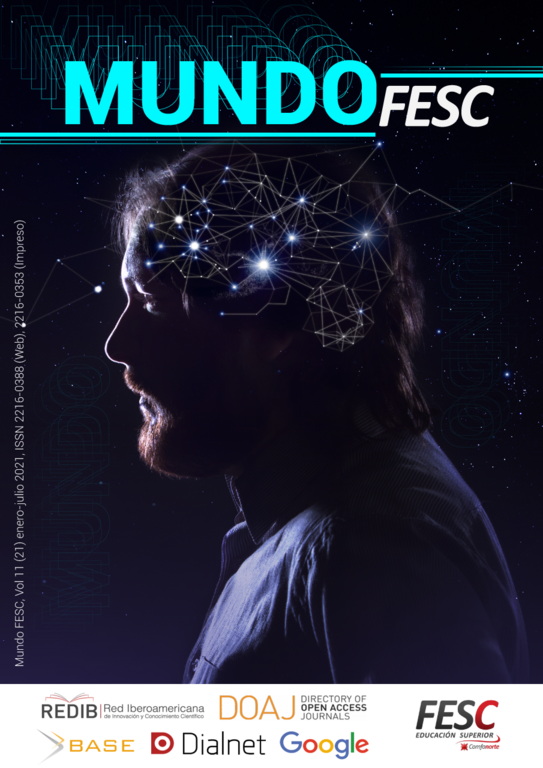Analysis of social capital on the Northern border of Santander-Tachira
Keywords:
Social Capital-Confidence-Associativity-Civic Awareness-Values.Abstract
This article analyses Social Capital in the Norte de Santander-Táchira border in 2012, a very complex year permeated by tensions between the two nations. The paper explains how social capital influences the income level of the population. From this perspective, it is possible to generate conditions for the well-being of the population. The access that social capital represents and means for the quality of life, and that it makes it possible to achieve various goals not only in economic terms, but also in other aspects (civic participation). It is based on Bernardo Kliksberg's approach, which identifies four components: The results show that the levels of trust are weak, as are the levels of associativity and cooperation, but also with regard to civic awareness there are important aspects such as the disrepute of public institutions and politics; Finally, it is not possible to think of a process of economic, social, political and cultural development and growth without including the perspective of social capital, and even more so in a territorial and cross-border space, which imprints complex dynamics and demands integral solutions in the increasingly volatile and convulsive context of bilateral relations between the two countries.
Downloads
References
J. Escobal, J. Saavedra, y M. Torero, M. Los activos de los pobres en Perú. Grupo de Análisis para el Desarrollo (GRADE). Lima: Banco Interamericano de desarrollo, 1999. https://publications.iadb.org/publications/spanish/document/Los-activos-de-los-pobres-en-el-Per%C3%BA.pdf
M. Woolcock, y D. Narayan, Social capital: implications for development theory, research, and policy. The WOTU Bank Research Observer, vol. 15, no. 2, pp. 225-249, 2000. Doi.org/10.1093/wbro/15.2.225
J. Durston, Capital social: parte del problema, parte de la solución, su papel en la persistencia y en la superación de la pobreza en América Latina y el Caribe. Capital social y reducción de la pobreza en América Latina y el Caribe: en busca de un nuevo paradigma. Santiago de Chile: CEPAL, 2003. [En línea]. Disponible en: https://repositorio.cepal.org/handle/11362/2329
P. Bourdieu, The Forms of Capital”, en Handbook of Theory and Research for the Sociology of Education. (Chapter 1), edited by Reinhard Kreckel, pp. 241-258, 1986. https://home.iitk.ac.in/~amman/soc748/bourdieu_forms_of_capital.pdf
J. S. Coleman, Social capital in the creation of human capital. American journal of sociology, vol. 94, pp. S95-S120, 1988. https://www.socialcapitalgateway.org/content/paper/coleman-j-s-1988-social-capital-creation-human-capital-american-journal-sociology-94-s
J. F. Helliwell, & R. D. Putnam, R.D. Economic growth and social capital in Italy. Eastern economic journal, vol. 21, no. 3, pp. 295-307, 1995. https://econpapers.repec.org/article/eejeeconj/a21_3ay_3a1995_3ai_3a3_3ap_3a295-307.htm
R. H. Stein, Capital Social, Desarrollo y Políticas Públicas en la realidad latinoamericana. Unidad de Políticas Comparadas (CSIC), pp. 1-36, 2003. https://digital.csic.es/bitstream/10261/1567/1/realidad_latinoamericana.pdf
R.D. Putnam, The prosperous community. The american prospect, vol. 4, no. 13, pp. 35-42. 1993. https://scholar.harvard.edu/robertputnam/publications/prosperous-community-social-capital-and-public-life
B. Barbini, Capital social y desarrollo. Aplicación de indicadores de capital social al ámbito turístico. Aportes y Transferencias, vol. 12, no. 2, pp. 65-91, 2008. https://www.redalyc.org/pdf/276/27615331005.pdf
M. Cacciuto, “La teoría del CAPITAL SOCIAL: análisis de sus aportes y aplicación a estudios turísticos orientados al desarrollo”, monografía. Universidad Nacional de Mar de Plata. Argentina, 2010. http://nulan.mdp.edu.ar/1148/1/cacciutto_m.pdf
M. González de la Rocha, “Oportunidades y capital social”, en Seminario Capital social y programas de superación de la pobreza: lineamientos para la acción, Santiago de Chile, Comisión Económica para América Latina y el Caribe (CEPAL), Santiago de Chile, 2003. https://www.cepal.org/es/publicaciones/5600-lineamientos-accion-diseno-programas-superacion-la-pobreza-enfoque-capital-social
F. Fukuyama, Social capital, civil society and development. Third world quarterly, vol. 22, no. 1, pp. 7-20, 2001. https://doi.org/10.1080/713701144
B. Kliksberg, Capital social y cultura claves esenciales para el desarrollo. Revista de la CEPAL No 69, pp. 85-102, 1999.https://www.cepal.org/es/publicaciones/12190-capital-social-cultura-claves-esenciales-desarrollo
D. Narayan, y L. Pritchett, Céntimos y sociabilidad: renta familiar y capital social en zonas rurales de Tanzania. Desarrollo económico y cambio cultural, vol. 47, no. 4,1999. Doi.org/10.1086/452436
C. Grootaert, y D. Narayan, Instituciones locales, pobreza y bienestar del hogar en Bolivia. Local level institutions. Working paper N°9. USA The World Bank, 2001. [En línea]. Disponible en: https://openknowledge.worldbank.org/handle/10986/19594
C. Grootaert, & T. Van Bastelaer, Understandingband measuring social capital: a synthesis of findings and recommendations from the social capital initiative. Working paper N° 24. Washington D.C.: USA The World Bank, 2001. [En línea]. Disponible en: http://www.casede.org/CapitalSocial/World_Bank_Understanding_social%20capital.pdf
D. Narayan, y M. Cassidy, Un enfoque dimensional para medir el capital social: desarrollo y validación de un inventario de capital social. Current sociology, vol. 49, no. 2, pp. 59-102, 2001. Doi.org/10.1177/0011392101049002006
B. Kliksberg, Los escándalos éticos de nuestro tiempo. Temas 66, pp. 2-11, 2011. [En línea]. Disponible en: http://www.asamblea.go.cr/sd/Documents/campanas/kliksberg.pdf
M. M. Cuéllar, Colombia un Proyecto Inconcluso: valores, instituciones y capital social. Bogotá: Universidad Externado de Colombia, 2000. https://revistas.uexternado.edu.co/index.php/ecoins/article/view/280/3252
T. Eggertsson, The role of transaction costs and property rights in economic analysis. European Economic Review, vol. 34, no. 2-3, pp. 450-457, 1990. Doi.org/10.1016/0014-2921(90)90118-I
M. Zambrano-Miranda, J E. Duque-Sastre, y J. Manzano, Medición del capital social: un análisis aplicado al barrio La primavera, Cúcuta. Documento de trabajo N°7. Observatorio Socioeconómico Regional de la Frontera -OSREF- Colombia: Universidad de Pamplona. 2015. [En línea]. Disponible en:http://www.unipamplona.edu.co/unipamplona/portalIG/home_72/recursos/01_general/14072016/documento7.pdf
B. Kliksberg, El voluntariado en Latinoamérica, siete tesis para la discusión. Cuadernos Latinoamericanos de Administración, vol. II, no. 3, pp. 9-16, 2007. https://www.redalyc.org/pdf/4096/409634346002.pdf
A. Sen, Desarrollo y Libertad. Buenos Aires: Planeta, 2000. https://www.palermo.edu/Archivos_content/2015/derecho/pobreza_multidimensional/bibliografia/Sesion1_doc1.pdf
R. Mazuera-Arias, N. C. Albornoz-Arias, C. Ramírez-Martínez, y M. A. Morffe-Peraza, Norte de Santander y Táchira: más que un límite fronterizo, subjetividades construidas en el territorio. Venezuela: Universidad del Zulia, 2017. https://bonga.unisimon.edu.co/handle/20.500.12442/2093
R. Linares, Seguridad y política fronteriza: una mirada a la situación de frontera entre Venezuela y Colombia. OPERA, vol. 24, pp. 135-156, 2019. Doi.org/10.18601/16578651.n24.08




